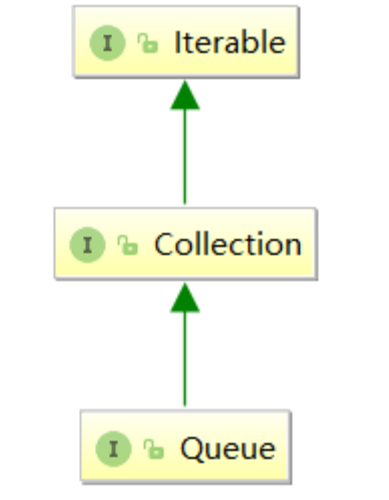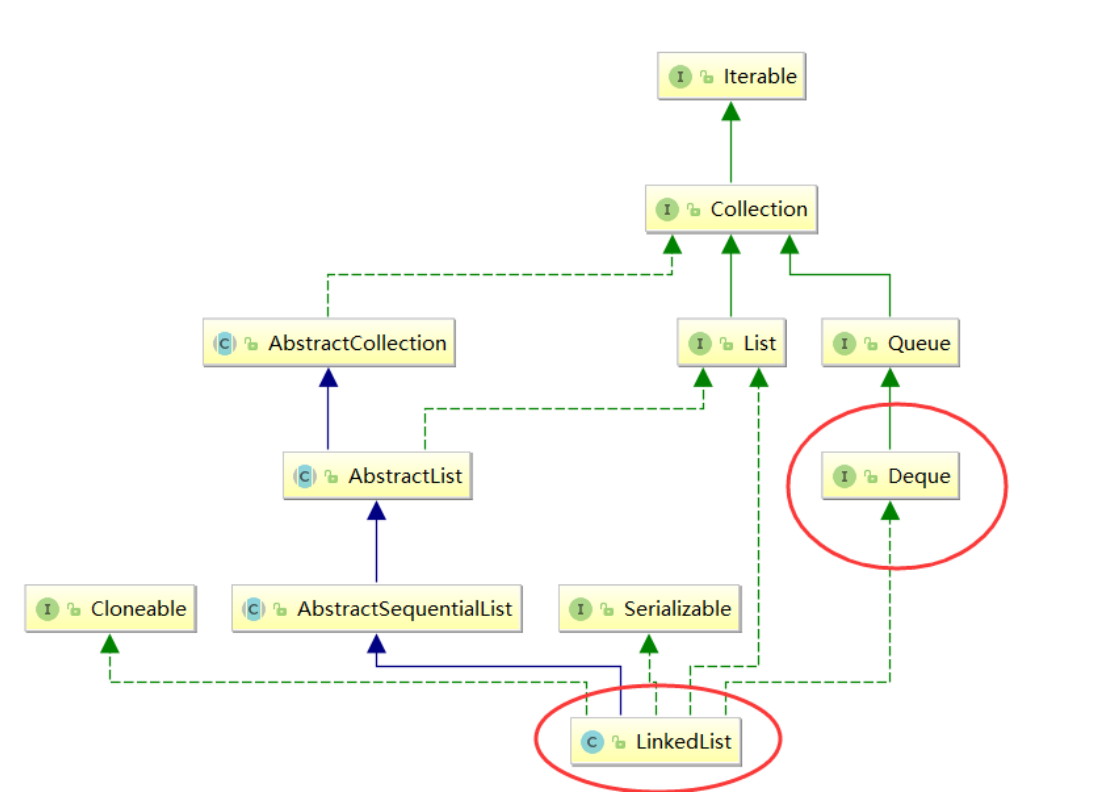1.概念
队列 : 只允许在一段进行插入数据操操作 , 在另一端进行删除数据操作的特殊线性表 ; 队列是 先进先出
入队列 : 进行插入操作的一端称为队尾
出队列 : 进行删除操作的一端称为对头

2.队列的使用
在Java中 , Queue 是一个接口 , 底层通过链表实现的

|--------------|-------------------------------------------|----------------|
| 方法 | 行为 | 说明 |
| add(E e) | 添加元素到队尾(若队列已满,抛出 IllegalStateException) | 推荐使用 offer() |
| offer(E e) | 添加元素到队尾(队列满时返回 false) | 更安全的插入方式 |
| remove() | 移除并返回队头元素(队列空时抛出NoSuchElementException) | 推荐使用 poll() |
| poll() | 移除并返回队头元素(队列空时返回 null) | 安全的移除方式 |
| element() | 查看队头元素(不删除,队列空时抛出异常) | 推荐使用 peek() |
| peek() | 查看队头元素(不删除,队列空时返回 null) | 安全的查看方式 |
java
public static void main(String[] args) {
Queue<Integer> queue = new LinkedList<>();
queue.offer(11);//添加元素到队尾
queue.offer(12);
queue.offer(13);
queue.offer(14);
queue.offer(15);
System.out.println(queue);//打印队列 [11, 12, 13, 14, 15]
int a1 = queue.poll();//移除头元素,并返回
System.out.println(a1);//11
System.out.println(queue);//[12, 13, 14, 15]
int a2 = queue.peek();//获取队头元素
System.out.println(a2);//12
}3.队列的模拟实现
①实现队列
java
public class MyQueue {
public static class ListNode{
public int val;
public ListNode prev;
public ListNode next;
public ListNode(int val){
this.val = val;
}
}
public int usedSize = 0;
public ListNode head = null;
public ListNode last = null;
public boolean isEmpty(){//检查是否为空
return usedSize == 0;//如果是空的 , usedSize为0 返回true
}
public void offer(int val){//入队列,采用的是尾插法
ListNode node = new ListNode(val);
if(isEmpty()){
head = last = node;//把node节点赋值给head和last
usedSize++;
}else {
last.next = node;
node.prev = last;
last = node;
usedSize++;
}
}
public int poll(){//相应的出队列应该采用,头删法
if(isEmpty()) {
return -1;
}
int vall = head.val;
head = head.next;
if(head != null){
head.prev = null;
}
usedSize--;
return vall;
}
public int size(){//返回大小
return usedSize;
}
}②测试
java
public static void main(String[] args) {
MyQueue myQueue = new MyQueue();
myQueue.offer(11);//添加元素到队尾
myQueue.offer(12);
myQueue.offer(13);
myQueue.offer(14);
myQueue.offer(15);
System.out.println(myQueue.poll());
}4.循环队列
- 循环队列是一种线性数据结构,其操作表现基于 FIFO(先进先出)原则并且队尾被连接在队首之后以形成一个循环。它也被称为"环形缓冲器"
- 循环队列的一个好处是我们可以利用这个队列之前用过的空间。在一个普通队列里,一旦一个队列满了,我们就不能插入下一个元素,即使在队列前面仍有空间
- 但是使用循环队列,我们能使用这些空间去存储新的值
|--------------------|---------------------|------------------|------------------------------------|-------------------------------|
| 方法名 | 描述 | 参数 | 返回值 | 特殊说明 |
| MyCircularQueue(k) | 构造器,初始化队列,设置队列容量为 k | int k(队列容量) | 无 | 内部实际使用 k+1 的空间来区分空满状态 |
| Front() | 获取队首元素 | 无 | int(队首元素值) | 队列为空时返回 - 1 |
| Rear() | 获取队尾元素 | 无 | int(队尾元素值) | 队列为空时返回 - 1 |
| enQueue(value) | 向队列插入元素 | int value(待插入元素) | boolean(插入成功返回 true,队列满则返回 false) | 插入后队尾指针循环后移 |
| deQueue() | 从队列删除队首元素 | 无 | boolean(删除成功返回 true,队列为空则返回 false) | 删除后队首指针循环后移 |
| isEmpty() | 检查队列是否为空 | 无 | boolean(为空返回 true,否则返回 false) | 当 front == rear 时队列空 |
| isFull() | 检查队列是否已满 | 无 | boolean(已满返回 true,否则返回 false) | 当 (rear+1) % 容量 == front 时队列满 |
java
class MyCircularQueue {
public int front;
public int rear;
public int[] elem;
public MyCircularQueue(int k) {
elem = new int[k+1];
}
//入队列
public boolean enQueue(int value) {
if(isFull()) {
return false;
}
elem[rear] = value;
rear = (rear+1)%elem.length;
return true;
}
//出队列
public boolean deQueue() {
if(isEmpty()) {
return false;
}
front = (front+1)%elem.length;
return true;
}
//得到队头元素
public int Front() {
if(isEmpty()) {
return -1;
}
return elem[front];
}
public int Rear() {
if(isEmpty()) {
return -1;
}
int index = (rear == 0) ? elem.length-1 : rear-1;
return elem[index];
}
public boolean isEmpty() {
return rear == front;
}
public boolean isFull() {
return (rear+1)%elem.length == front;
}
}5.双端队列(Deque)
双端队列 是 指允许两端都可以进行入队和出队操作的队列

Deque是一个接口, 使用时 必须创建LinkedList对象

Deque的接口比较多 , 栈和队列均可以实现该接口
java
public static void main(String[] args) {
Deque<Integer> stack = new LinkedList<>();//双端队列的链式实现
Deque<Integer> queue = new ArrayDeque<>();//双端队列的线性实现
}6.用队列实现栈
- 模拟的入栈操作 : 将元素放到不为空的队列中
- 模拟的出栈操作 : 把不为空的队列中的size-1个元素放到另一个队列中 ; 最后剩下的就是模拟栈中的顶层元素
java
import java.util.LinkedList;
import java.util.Queue;
class MyStackUseQueue {
public Queue<Integer> qu1;
public Queue<Integer> qu2;
public MyStackUseQueue() {
qu1 = new LinkedList<>();
qu2 = new LinkedList<>();
}
public void push(int x) {
if(!qu1.isEmpty()) {
qu1.offer(x);
}else if(!qu2.isEmpty()) {
qu2.offer(x);
}else {
qu1.offer(x);
}
}
public int pop() {
if(empty()) {
return -1;
}
if(!qu1.isEmpty()) {
int size = qu1.size();
for(int i = 0;i < size-1;i++) {
qu2.offer( qu1.poll());
}
return qu1.poll();
}else {
int size = qu2.size();
for(int i = 0;i < size-1;i++) {
qu1.offer( qu2.poll());
}
return qu2.poll();
}
}
public int top() {
if(empty()) {
return -1;
}
if(!qu1.isEmpty()) {
int size = qu1.size();
int val = 0;
for(int i = 0;i < size;i++) {
val = qu1.poll();
qu2.offer(val);
}
return val;
}else {
int size = qu2.size();
int val = 0;
for(int i = 0;i < size;i++) {
val = qu2.poll();
qu1.offer(val);
}
return val;
}
}
public boolean empty() {
return qu1.isEmpty() && qu2.isEmpty();
}
}7.用栈实现队列
- 模拟入队操作 : 放到第一个栈中
- 模拟出队操作 : 判断第二个栈是否为空 ?
如果为空 : 需要把第一个栈中的所有元素都放到第二个栈里 , 取出第二个栈中的顶层元素
如果不为空 : 直接取出第二个栈中的顶层元素
java
import java.util.ArrayDeque;
class MyQueueUseStack {
public ArrayDeque<Integer> stack1;
public ArrayDeque<Integer> stack2;
public MyQueueUseStack() {
stack1 = new ArrayDeque<>();
stack2 = new ArrayDeque<>();
}
public void push(int x) {
stack1.push(x);
}
public int pop() {
if(empty()) {
return -1;
}
if(stack2.isEmpty()) {
//第一个栈里面所有的元素 放到第二个栈当中
while(!stack1.isEmpty()) {
stack2.push(stack1.pop());
}
}
return stack2.pop();
}
public int peek() {
if(empty()) {
return -1;
}
if(stack2.isEmpty()) {
//第一个栈里面所有的元素 放到第二个栈当中
while(!stack1.isEmpty()) {
stack2.push(stack1.pop());
}
}
return stack2.peek();
}
public boolean empty() {
return stack1.isEmpty() && stack2.isEmpty();
}
}